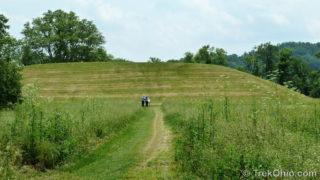Hopewell Culture National Historical Park: Seip Mound
Seip Mound State Memorial Park is one of the five noncontiguous sites that make up the Hopewell Culture National Historical Park. The other four sites are Hopeton Earthworks, Hopewell Mound Group, High Banks Works, and the Mound City Group (reviewed by us here). Native Americans belonging to the Hopewell tradition constructed this mound sometime between 100 B.C. – A.D. 400. The mound pictured above was part of a larger earthworks complex. At a number of sites in Ohio, Native Americans of this era constructed earthen walls in the shape of immense, geometric shapes, typically consisting of two circular figures and a square. To give you an idea of the size, the embankment walls were 10,000 feet in length and enclosed 121 acres. When surveyed in 1848, the Seip Earthworks looked like the illustration below. Local farmers leveled most of the wall to create fields. However two huge, elliptical mounds remained intact until archeologists excavated them in the 1920s. When I say that the mounds were excavated, I mean that archeologists completely dug them up and sifted through the dirt to remove artifacts and skeletal remains. So the mound that you now see when visiting this site is actually a reconstruction of Seip Earthwork’s largest mound. It is described by E.G. Squier (the man who surveyed it in 1848) as being 240 feet long, 160 feet wide, and 30 feet high. Although the outer surface of the reconstructed mound is soil on which grass grows, Squier described the original mound as having a surface consisting of small rocks and pebbles. Squier also said that there were three beautiful mounds made entirely of clay in the vicinity. These have long since disappeared. All the mounds within the Seip Earthworks were used to inter the remains of individuals, most of whom had been cremated. However at the base of one of the two great mounds in the large circle’s center, there was a log crypt. The remains of the people who had been laid to rest within the crypt appear to have been treated differently from others. The crypt contained the remains of four adults who were lying side by side on their backs. Above their heads at a 90 degree angle with respect to the adults were the remains of two infants. This burial chamber contained thousands of pearls, so many that newspaper accounts of the era referred to the tomb as the “great pearl burial”. Many other fine artifacts were also interred in this chamber. The individuals in the crypt apparently wore or were draped with a linen burial shroud. At the time of the excavation this linen was said to resemble the weave, texture, and color of pioneer-style, homespun linen. I used to imagine woodland Indians dressing exclusively in leather and animal skins. However early settlers have described the Native Americans of their era as wearing colorful fabrics. The Hopewell Indians lived over a thousand years before these settlers, but apparently even their fabric employed colorful dyes. Scientists are now … Continue reading Hopewell Culture National Historical Park: Seip Mound
